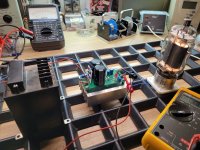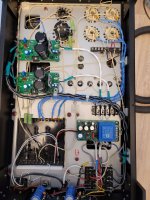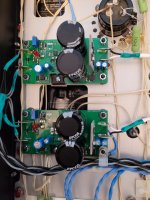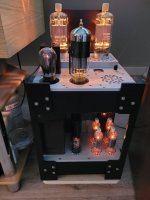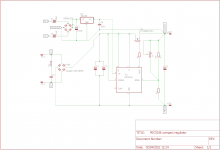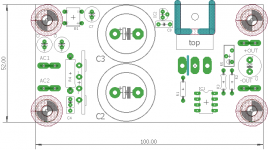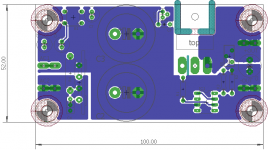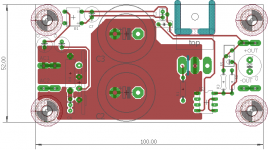This is a little project of mine, based on some modules i made for someone i know who had noise issues with AC heating in his 813PP amplifier.
The original design specifications called for a module that was capable of making 10VDC 5A out of 10VAC with optional soft start and very low noise.
The modules use the off the shelf "Saligny" rectifier boards. https://evotronix.eu/main/
I have redesigned the original design to exclude SMD components.
The controller is a MIC5156YM and the FET is a IXTH80N075L2 for absolute reliability.
I will be posting gerbers in this thread once im finished with the redesign.
The original design specifications called for a module that was capable of making 10VDC 5A out of 10VAC with optional soft start and very low noise.
The modules use the off the shelf "Saligny" rectifier boards. https://evotronix.eu/main/
I have redesigned the original design to exclude SMD components.
The controller is a MIC5156YM and the FET is a IXTH80N075L2 for absolute reliability.
I will be posting gerbers in this thread once im finished with the redesign.
Attachments
I believe that the biggest issue in DC filament supply is not the voltage or current regulator, but the SS rectifiers, which are intrinsically noisy. The worst is bridge rectifier feeding a capacitor. Two diodes with center-tapped transformer winding is better. Choke input is the next goodness level.
The type of diode is crucial. Ultrafast diodes may have low switching noise, but their abrupt cutoff at relatively high forward voltage causes bad resonant tank ringing of transformer winding. Snubbing mitigates this ringing only partially. Here "ultraslow" diodes are much better. Early germanium power diodes are not only slow, but those with low voltage rating have lower forward voltage than any modern type, on the order of 0.1 V, compared to 0.4-1.5 V of modern diodes.
For a 5-10 V supply, the best is GD2-115 (20 V 10 A), for higher voltages D305 (50 V 10 A). Relatively high reverse current of these diodes is a plus, which can be further improved by bypassing diodes with resistors.
The type of diode is crucial. Ultrafast diodes may have low switching noise, but their abrupt cutoff at relatively high forward voltage causes bad resonant tank ringing of transformer winding. Snubbing mitigates this ringing only partially. Here "ultraslow" diodes are much better. Early germanium power diodes are not only slow, but those with low voltage rating have lower forward voltage than any modern type, on the order of 0.1 V, compared to 0.4-1.5 V of modern diodes.
For a 5-10 V supply, the best is GD2-115 (20 V 10 A), for higher voltages D305 (50 V 10 A). Relatively high reverse current of these diodes is a plus, which can be further improved by bypassing diodes with resistors.
Sorry, I didn't look at the Evotronix. From information there, their diodes have extremely low forward voltage of 3 mV! It beats Ge diodes and is the way to go. But not with capacitor input filter.
Here are some images of the current board layout and schematic.
I have allready tested the principle in the original units, these units are just simplified through hole versions.
I have allready tested the principle in the original units, these units are just simplified through hole versions.
Attachments
Sorry, I didn't look at the Evotronix. From information there, their diodes have extremely low forward voltage of 3 mV! It beats Ge diodes and is the way to go. But not with capacitor input filter.
They're probably using an LT4320 and some low rds mosfets. Some of the mosfets out there now have on resistance lower than the pcb traces.
Yes they are, they are using the mosfets from the LT4320 datasheet, but their product beats developing a multilayer PCB from scratch. especially if the mosfets and controller already push 20USD or so.
Do germanium rectifiers leak and fail like their transistor counterparts? I've bought US and soviet power transistors and out of 10 you can probably get 2-4 useable examples. The rest are either outright bad or have gain in the single digits. A batch of 25 transistors from Bendix yielded about 4 useable.
Yes they do, they also suffer from Whiskers. Curiously enough i had a Philips PE4817 bench power supply that had a SCR and Silicon rectification chain but was almost completely filled with Ge transistors that caused whiskers.
I try to stay away from equiptment that uses Germanium transistors nowadays.
I try to stay away from equiptment that uses Germanium transistors nowadays.
It's amazing the complexity of these DC filament supplies.
Way too "busy" in my opinion to do a simple job, but hey, I suppose some enjoy the task of making them so complex.
In my opinion, simplicity, along with reliability is more to my liking.
So with that said, a nice TO3 transistor booster, controlled by a 78Lxx regulator in a simple circuit, is elegant.
And with a mere few parts, the regulator provides a "soft start" if really needed.
And the supply is noiseless as well.
Way too "busy" in my opinion to do a simple job, but hey, I suppose some enjoy the task of making them so complex.
In my opinion, simplicity, along with reliability is more to my liking.
So with that said, a nice TO3 transistor booster, controlled by a 78Lxx regulator in a simple circuit, is elegant.
And with a mere few parts, the regulator provides a "soft start" if really needed.
And the supply is noiseless as well.
Complexity in this case is a result of design requirements, if i had a 12VAC transformer and plenty of cooling, i could have designed it with 2N3055 or 2N3773
But the saturation voltage of most BJT's is too high to provide enough headroom for regulation. and 2N3773 or 2N3055 dont even have VCEsat specified.
The MIC5156 is a convienient 5 Dollar controller, that allows for using a very large FET to do pass duty here. and the only added complexity is the voltage doubler and little TO92 regulator for the gate drive voltage.
I added the 7809/ to make sure that this supply would also work from 18VAC => 20VDC for GM70. As the 5156 has an internal 12V clamp diode from VP to output.
But the saturation voltage of most BJT's is too high to provide enough headroom for regulation. and 2N3773 or 2N3055 dont even have VCEsat specified.
The MIC5156 is a convienient 5 Dollar controller, that allows for using a very large FET to do pass duty here. and the only added complexity is the voltage doubler and little TO92 regulator for the gate drive voltage.
I added the 7809/ to make sure that this supply would also work from 18VAC => 20VDC for GM70. As the 5156 has an internal 12V clamp diode from VP to output.
I would never use old Ge power transistors. Those that work, tend to do thermal runaway even with heat sinks. I didn't have problems with Ge diodes, just need to keep them cool.Do germanium rectifiers leak and fail like their transistor counterparts? I've bought US and soviet power transistors and out of 10 you can probably get 2-4 useable examples. The rest are either outright bad or have gain in the single digits. A batch of 25 transistors from Bendix yielded about 4 useable.
The 2N3773 = NTE284 which gives a Vce of IC =10A, Ib=1A, Max 3V.Complexity in this case is a result of design requirements, if i had a 12VAC transformer and plenty of cooling, i could have designed it with 2N3055 or 2N3773
But the saturation voltage of most BJT's is too high to provide enough headroom for regulation. and 2N3773 or 2N3055 dont even have VCEsat specified.
The MIC5156 is a convienient 5 Dollar controller, that allows for using a very large FET to do pass duty here. and the only added complexity is the voltage doubler and little TO92 regulator for the gate drive voltage.
I added the 7809/ to make sure that this supply would also work from 18VAC => 20VDC for GM70. As the 5156 has an internal 12V clamp diode from VP to output.
There ya go.
I've used the NTE 180/181's too, with excellent results boosting LM78xx's for various projects.
I have described a number of simplistic filament regulators, which have been used successfully by some members, but due to the lousy search function of the new forum software, I am unable to retrieve them.
IIRC, the latest one was capable of several amperes and had a dropout of 100mV, using only plain-vanilla parts (and it was successfully tried and tested by a member).
If you are patient or determined enough, you can browse through hundreds of my posts, assuming you can break the 10 pages limit imposed by the forum.
You will probably have more chances using google, but good luck anyway!
IIRC, the latest one was capable of several amperes and had a dropout of 100mV, using only plain-vanilla parts (and it was successfully tried and tested by a member).
If you are patient or determined enough, you can browse through hundreds of my posts, assuming you can break the 10 pages limit imposed by the forum.
You will probably have more chances using google, but good luck anyway!
Have you tried searching by using your own file name for something?I have described a number of simplistic filament regulators, which have been used successfully by some members, but due to the lousy search function of the new forum software, I am unable to retrieve them.
IIRC, the latest one was capable of several amperes and had a dropout of 100mV, using only plain-vanilla parts (and it was successfully tried and tested by a member).
If you are patient or determined enough, you can browse through hundreds of my posts, assuming you can break the 10 pages limit imposed by the forum.
You will probably have more chances using google, but good luck anyway!
That might work.
The 2N3773 = NTE284 which gives a Vce of IC =10A, Ib=1A, Max 3V.
There ya go.
I've used the NTE 180/181's too, with excellent results boosting LM78xx's for various projects.
There any many newer parts on the market now. The mosfet in the first post has an on resistance of 0.024 ohms! Look at the specs for the LT3042 https://www.analog.com/en/products/lt3045.html#product-overview
"newer" is not always better.There any many newer parts on the market now. The mosfet in the first post has an on resistance of 0.024 ohms! Look at the specs for the LT3042 https://www.analog.com/en/products/lt3045.html#product-overview
I'm not impressed.
Well koda, and for the snotty #17 comment from astouffer too.....Everyone I've ever talked to has said NTE parts are utter trash... Did something change?
I've heard throughout the internet for years now, the put-downs about Philips/Sylvania/ECG/NTE, and wondered why is that?
I've been in the professional service business for decades, and having serviced tens of thousands of products in that time.
The only thing I can come UP with is perhaps someone in the past misused or abused something that they had with replaced ECG parts.
Who knows, maybe ECG/NTE got a bad batch during their transition, or maybe that someone went to a china site that sold fakes, who knows?
Anyhow, the internet-generated an ongoing tirade of negativity, which surprised me, and you know things like that spread like fire on the 'net forever.
The old "wives tales" type of thing.
Regardless, the shop I was last at for 25 years mainly stocked ECG/NTE, along with Toshiba, GE, etc.
And we've never had issues or callbacks from customers about replaced parts failing, asides from obvious abuse, which is not covered under our repair warranty, naturally.
When we finally closed in 2016, I brought home the stock of ECG/NTE - bins of transistors, etc, enough to last me for decades.
Do you think I'd waste my time on bringing home anything that I ever thought was going to be a problem?
Hell no!
Do you think that big parts houses like Mouser, among many others, would want to carry the NTE brand and compromise their own reputation?
I don't think so.
So anyone who comes at me with the claim that NTE is unreliable or sub-standard junk is in my honest professional opinion - some kinda nutbag spouting BS that they "heard" and decided to continue to spread the unfounded bias.
This wrongful attitude towards a long-running successful company that has done nothing wrong in my opinion needs to cease.
Apparently, Mouser hasn't sold NTE for 5 years...
Most people I read are talking about how they fail as HOTs in CRT tv's, and the "cross reference" isn't accurate at all. I dunno. I've only ever bought one NTE part to replace s 2N3055... It functioned, but the 2N3055 isn't exactly known as being a high end part, either.
It was an NTE181 I think. 5 times the cost of a 2N3055, but it was available at the local crap store.
Personally, I though the comment about whale oil was funny 🙂
Most people I read are talking about how they fail as HOTs in CRT tv's, and the "cross reference" isn't accurate at all. I dunno. I've only ever bought one NTE part to replace s 2N3055... It functioned, but the 2N3055 isn't exactly known as being a high end part, either.
It was an NTE181 I think. 5 times the cost of a 2N3055, but it was available at the local crap store.
Personally, I though the comment about whale oil was funny 🙂
- Home
- Amplifiers
- Tubes / Valves
- Efficient 10VDC 5A filament supply 211 845 814 813
